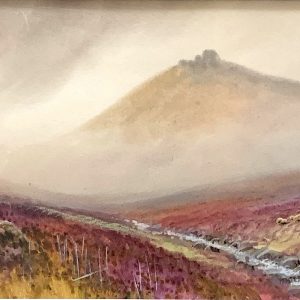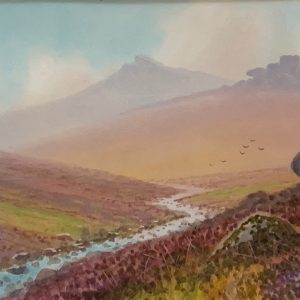Douglas Houzen Pinder
[bg_collapse view=”link” color=”#4a4949″ icon=”zoom” expand_text=”Artist Biography” collapse_text=”Show Less” ]
Douglas Houzen Pinder 1886 – 1949
Douglas Houzen Pinder painted in oils and more frequently in watercolour, favouring coastal views, moorland landscapes and desert scenes. According to most biographies he was born in Lincoln in 1886 but the GRO index and census returns clearly indicate that he was born in Derbyshire at Starkholmes and registered in the Bakewell RD towards the end of 1886. His father, a schoolmaster died in 1887, so by 1891 his mother had returned to Lambeth where she first had married, and became a school teacher. By 1901 the family had moved to Newquay where Douglas’s mother is recorded as an infant mistress in a board school..
In the early 1900s, Douglas Pinder was articled to a local architect. The 1901 census describes him as an architect’s apprentice but he then turned to painting full time and is described as an artist in 1911. In the meantime he had married Edith Jane Osborne from St Wenn in 1908.
Motivated by membership of the Plymouth Brethren, on 19 June 1916 Pinder appeared as a conscientious objector before the Newquay Military Service Tribunal. He was exempted from combatant service, entailing call-up to the Non-Combatant Corps. He served until July 1918, when with four others he was court-martialled for disobedience. It is presumed they were given an order contrary to conscience. On 26 July 1918 he was sentenced to two years imprisonment with hard labour, and sent to Wormwood Scrubs Prison. There he was interviewed by the Central Tribunal, who found him to be a genuine conscientious objector, and he was released from prison.
Later also he was sponsored to go to Egypt to paint a number of Desert Scenes from the station at Base Said. For about two years, Pinder lived at Rose Villa in Horrabridge on Dartmoor, where he painted moorland scenes which he often signed ‘Ben GRAHAM’. He also lived in Plymouth for some period. By 1930 he was back in Newquay, painting and selling art in his own gallery at 80, Fore Street.
He did not drive a car, but used a bicycle, heading off to many locations along the north Cornish coast, with a special carrier attached to the bike’s crossbar for his painting equipment. He painted many watercolours and a far smaller number of oils, usually seascapes, which often included details that allowed the location to be clearly identified. He did not exhibit with art societies, preferring to handle his own work in Newquay. His early work is signed D H Pinder, while later works are signed DOUGLAS (H) PINDER in a printed script.
He died towards the end of 1949 at the age of 63. A view of Polperro was exhibited posthumously in 1950 at the Plymouth Art Society Exhibition.
He painted many watercolours and a far smaller number of oils. He usually painted seascapes, often including detail which allowed the location to be clearly identified. He did not exhibit with art societies, preferring to handle his own work His early work is signed D H Pinder, while later works are signed DOUGLAS (H) PINDER in a printed script.
[/bg_collapse]
Showing all 2 resultsSorted by latest


